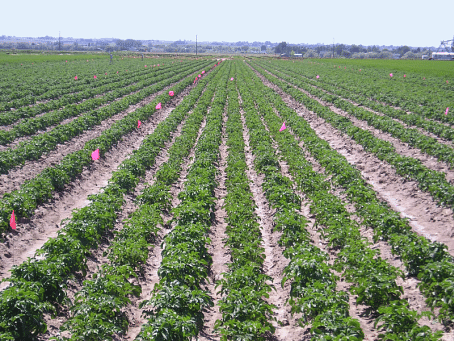How to use less water and grow more potatoes
How to use less water and grow more potatoes

Research conducted in part at the U.S. Department of Agriculture (USDA) has confirmed that in some production systems, planting potatoes in flat beds can increase irrigation water use efficiency.
Agricultural Research Service (ARS) agricultural engineer Bradley King, who works at the ARS Northwest Irrigation and Soils Research Laboratory in Kimberly, Idaho, was one of the scientists who led these studies. ARS is USDA's chief intramural scientific research agency, and this research supports the USDA commitment to enhancing sustainable agriculture.
When potato production started in Idaho more than 100 years ago, farmers seeded their crops in ridged rows and watered their plants by channeling surface irrigation to flow through the furrows between the rows. Even though most commercial potato producers in the Pacific Northwest now irrigate their crops with sprinklers, they still typically use ridged-row planting systems.
But this planting configuration allows irrigation runoff to collect in the furrow and percolate below the crop root zone. This means that the water is unavailable to the crops, and can also lead to increased nitrate leaching from the soil.
Planting potatoes in flat beds requires less water than planting in ridges. Photo shows 36"ridges (Photo Courtesy ARS)
King and his partners conducted a series of studies on planting potatoes in flat beds instead of ridged rows. One two-year study compared ridge-row planting systems, a 5-row planting configuration on a raised bed where the plant rows were 26 inches apart, and a 7-row planting configuration on a raised bed where the plant rows were 18 inches apart. Another 5-year study on approximately 6,900 acres only compared ridged-row systems and 5-row raised-bed systems.
The researchers found that using the flat bed system increased yields by an average of 6 percent, even though 5 percent less water was used for irrigation. This meant that using flat beds instead of ridged rows for potato production led to an overall 12 percent increase in irrigation water use efficiency. The gains were attributed to several factors, especially the probability that planting potatoes in flat beds improves water and nitrogen use efficiency because more water reaches the potato roots.
Planting potatoes in flat beds requires less water than planting in ridges. Photo shows seven-row planting configuration on a 12-foot-wide raised bed with rows spaced 18 inches apart. (Photo Courtesy ARS)
These findings, which were published in 2011 in the American Journal of Potato Research, could help commercial farmers increase yields and profits, save valuable water resources, and reduce nitrate leaching.











